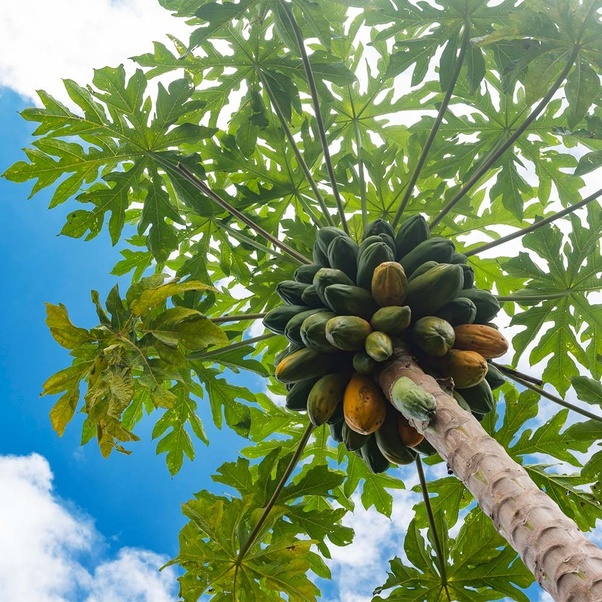How to grow and care for a papaya tree
Unlock the secrets of growing papaya trees in Sydney! Discover essential tips for cultivation, harvesting, and care in this comprehensive guide.
Papaya trees can be male, female or hermaphrodite (i.e., with male and female reproductive organs on the same flower). Male trees produce clusters of creamy-white flowers on long spikes or ‘panicles’. Female trees have solitary flowers or clusters of larger flowers on shorter stalks. Hermaphrodite trees produce flowers like those of female trees, but they are thinner and have a tubular shape. Papaya fruit is oblong or football-shaped, with green-yellow skin and bright red-orange flesh surrounding an internal cavity of round black seeds.

What’s the difference between papaya and pawpaw?
Papaya and pawpaw are the same species but different cultivars. They can be distinguished by their fruit colour and shape. Papaya is typically pear-shaped with red-orange flesh, while pawpaw is rounder, with yellow skin and flesh. Papaya is also sweeter than pawpaw.
Uses for papaya
Papaya trees are grown for their fruit, which can be eaten fresh, blended in smoothies or used as an ingredient in baked dishes. Unripened papaya (also known as green papaya) is a key ingredient in Thai or Vietnamese papaya salad.The trees look exotic and make wonderful feature plants in the garden or a large pot.
Papaya Care Guide :
Watering :
Papaya plants are drought-tolerant. Allow the soil to dry completely between watering sessions.
Fertilization:
Fertilize once in spring to promote healthy growth.
Pruning:
Trim diseased or withered leaves once a month to maintain plant health.
Planting Guidelines
Planting Time:
Ideal planting times are spring and summer.
Harvest Time:
Papayas can be harvested all year round.
Propagation Methods:
Papayas can be propagated through cuttings or sowing seeds.
Potting Suggestions :
Ensure pots have excellent drainage to prevent waterlogging.
Papaya Growing Conditions
Difficulty Rating
Growing papaya is easy as long as their needs are met. They are, however, sensitive to certain types of pests and diseases.
Sunlight
Papaya plants require full sun to thrive.
Hardiness
Papayas can tolerate temperatures down to 30°F.
Hardiness Zones
Suitable for USDA hardiness zones 10-12.
Soil Requirements
Prefer sandy or loamy soil that is well-drained.
Soil pH can be slightly acidic, neutral, or slightly alkaline.
Positioning Papaya Plants:
Papaya plants are soft and susceptible to frost and cold winds, so they should be grown in a sheltered, warm location that mimics their subtropical origins.
Outdoor Positioning: Select a sheltered, warm spot that provides protection from frost and cold winds.
Indoor Positioning: Papayas also thrive in pots, allowing you to move them to optimal locations throughout the seasons. They make lovely indoor plants during winter, providing protection from frost damage.
Papayas flourish in compost-rich, free-draining soil with regular feeding, but be careful not to over-fertilize. In areas with clay soil, enhance the soil with organic matter and plant the tree on a raised bed to improve drainage.
Planting Paw Paw Trees
Plant your paw paw tree after the last threat of frost has passed and the soil has warmed up, typically from the beginning of November to February.
Timing: Plant from November to February to avoid frost damage and give your tree time to establish before the next winter.
Protection: Young trees are more sensitive to cold and may need protection from frost during their first few winters.
Ensure the soil is warm and all frost risks have passed to provide the best start for your paw paw tree.
Planting and Care for Paw Paw Trees
Planting:
Pre-planting Preparation:
Water the pot thoroughly before planting your tree into the ground.Improve the soil by following our tips for soil preparation.Apply a seaweed tonic, such as Seasol, when watering in.
Watering and Feeding:
Keep the tree well-watered and fed during summer as they are heavy feeders and grow rapidly.Add compost and aged manure to maintain soil health and improve water retention.
Soil and Mulching:
Ensure the soil is free-draining to prevent root rot, as paw paw trees have shallow root systems and are susceptible to "wet feet."
Mulch with a 100mm layer of quality organic mulch, keeping the mulch away from the trunk.
Pest Management:
Protect against common garden pests like fruit flies, birds, and possums using netting and exclusion products.
Disease Management:
In colder climates, paw paw trees may be susceptible to powdery mildew and black spot.
Remove affected growth or treat with a recommended fungicide if these diseases appear.
Harvesting and Pruning Paw Paw Trees:
Harvesting
Timing: If planted between November and January, expect to harvest your first crop between October and December of the following season.
When to Pick: Harvest the fruit when it is firm.
Pest Prevention: To avoid pests, pick the fruit earlier and place it indoors near a banana to encourage ripening.
Requirements: Paw paw trees generally do not require much pruning.
Pruning :
Height Management: If the tree grows too tall to harvest the fruit, you can cut it back to a manageable height.
Timing: Pruning should be done in warmer weather.
Also Read :Ultimate Guide to Growing Healthy Dragon Fruit Plants
